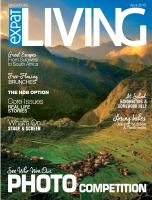

120
LIFE&FAMILY
April15
ENVIRONMENT
CORAL SURVIVAL
It seems a contradiction to write the words “coral”
and “waste disposal” in the same sentence. But
Singapore has cleverly found a way to preserve
coral, while taking care of the island’s garbage.
Development at Semakau Landfill, an offshore
waste disposal facility, necessitated closing an
existing gap in the island lagoon and relocating
the fragile corals that had developed on the patch
reefs in the area. It took four months to move 700
coral colonies to nearby Sisters’ Island Marine Park.
While it’s not a place to go scuba diving any time
soon, it’s clear that tremendous effort has gone into
saving the precious organisms. Monitoring surveys
will be carried out regularly to assess the health of
the transplanted corals.
nea.gov.sg
In February, global non-profit
Forum
for the Future
launched
The Futures
Centre
in Singapore, a digital platform
to help business, government and
other organisations solve complex
sustainability challenges. Users can tap
into futures knowledge across diverse
fields including land-use, manufacturing
and ecosystem health; the site makes
fascinating reading for anyone who is
generally interested in sustainability
issues. A specific focus on sustainable
shipping is planned for release this
month. The Singapore Exchange
recently mandated that all listed
companies (about 800) should publish
sustainability reports by 2017 or 2018.
thefuturescentre.org
FORESTS
FOR THE
FUTURE
According to the World Wildlife Fund (WWF), the equivalent of 36 football
fields is lost to deforestation every minute. The devastating environmental
consequences are well documented, in particular to tropical rainforests,
which are home to much of the world’s biodiversity. A new report by
The
Global Canopy Programme
, the Forest 500, identifies, ranks, and tracks the
governments, companies and financial institutions that together could put a
stop to tropical deforestation.
According to the report, tropical forest loss and degradation is
predominantly driven by the production of globally traded “forest risk”
commodities: palm oil, soya, beef, leather, timber, and pulp and paper.
Through complex supply chains – from producers to traders, processors,
manufacturers and retailers – these commodities end up in over 50
percent of packaged goods in supermarkets worldwide. The scale is huge;
companies identified in the report represent revenues in excess of US$4.5
trillion. The upshot, according to the report, is that these commodities can be
produced sustainably without impacting tropical forests.
forest500.org
On Sustainability



















